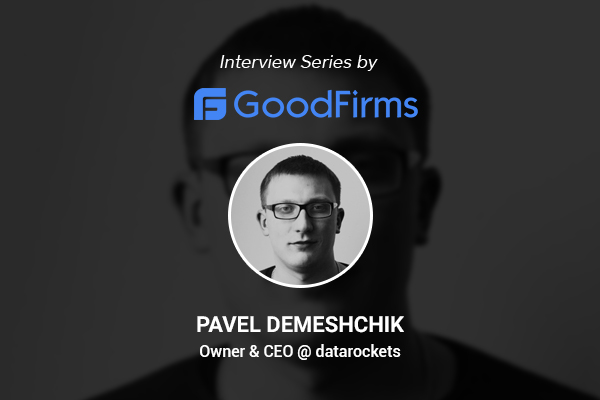
datarockets founders, Pavel and Dmitry, worked for leading outsourcing companies in the industry before they started their own company that develops web and mobile applications of any complexity. They observed the ecosystems that lacked transparency, were indifferent towards the success of clients’ projects, and there was a certain unwillingness to invest in the personal growth of the engineering teams. This compelled them to build a place for like-minded people where they can integrate with clients as a single team, based on a transparent development process.

To further understand datarockets’ vision, GoodFirms has interviewed datarockets CEO, Pavel as part of their interview series. The following information is an extract from that conversation.
datarockets is an experienced team of product developers with offices in Toronto, Canada, and Minsk, Belarus.
We know how to build successful web & mobile applications and do our best to share that experience with our clients. I believe we have a very special approach when building relationships with our customers, which results in productive partnerships that last for years.
At datarockets, we use Holacracy to distribute roles between people, so my roles are constantly evolving. In short, I have the pleasure to:
Our business model is called “Dedicated Team”. We don’t outsource and prefer to rely on our own resources. Working as dedicated teams means a close integration into our clients’ businesses and their teams. This way, we create a productive environment where we grow together with our customers.
Apart from actual coding, we bring our ideas to the table. Writing high-quality code is what we do by default, but there are many good engineers out there, and we go the extra mile to stand out. We contribute to our projects by sharing our culture, bringing our processes, and providing our ideas on how to make things faster/better.
Our major strength is transparency and simplicity. datarockets’ clients don’t worry about the technical part of their products anymore – we handle that. We set up clear work and communication processes, so our clients can see what we discuss, how we make decisions, and what issues we experience in real-time. Our team lets our customers focus on what really matters to them: overall product strategy, finances, and marketing.
We try to automate as much routine work as possible. Our engineers don’t really enjoy the work that can be done by robots/scripts, and that always turns out to be very beneficial for our customers.
We don’t stick to a specific industry. Our team consists of people who are fond of complex architectures, like to resolve complex problems and create something really useful. We never stop learning. The best way to use all this knowledge and learn more is to take different kinds of projects.
For the last 6 years, we have been building products for the following industries:
Almost all of our clients come back to us with new projects and refer their business partners/friends to us.
To provide as accurate as possible estimate, we need to know as much as possible. Usually, before we give an estimate, we try to determine:
Our estimation process is collaborative and transparent. Our prospective clients see how much time we plan to spend on each feature/change and free to share their questions/concerns during the process.
We bill for our time only. When a project needs to be done in a certain budget and time, we usually apply the FFF approach (Fixed Price, Fixed Time, Flexible Scope). What we do in this case:
This way, at any time, we have a working version of the product. When we get closer to the deadline, we can stop and skip some minor features, but deliver the most crucial functionality under the budget.
We don’t like fixing the overall project/milestone cost for the following reasons:
datarockets’ product vision, transparency with clients, and strong development culture have resulted in a high place amongst the top software development companies in Canada and top app developers in Toronto.
Robert Osborne, Director Of Engineering at Freckle IoT, said this about the work with datarockets:

In the full interview, Pavel also mentioned key parameters needed for selecting the right framework for developing software and applications. Also, he answered the most popular client’s question about the minimum budget required for developing a project.
To understand the whole vision of datarockets, please read the full interview in the datarockets profile on GoodFirms.
Washington, D.C. based GoodFirms is a maverick B2B research and Reviews Company that helps service-seekers in finding software development and mobile app development companies that are rendering the best services in the industry. GoodFirms’ bonafide research process ranks companies, boosts their online reputation, and helps businesses choose the right technology partner that meets their requirements.
Many thanks to Anna Stark, the Content Writer at GoodFirms, for the help in preparing the interview and press release.
Check out our newsletter